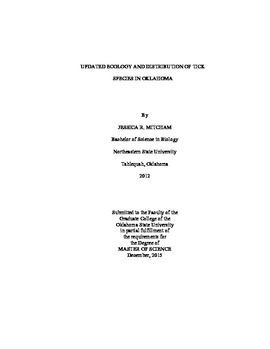| dc.contributor.advisor | Noden, Bruce | |
| dc.contributor.author | Mitcham, Jessica Ryan | |
| dc.date.accessioned | 2017-02-22T22:12:54Z | |
| dc.date.available | 2017-02-22T22:12:54Z | |
| dc.date.issued | 2015-12-01 | |
| dc.identifier.uri | https://hdl.handle.net/11244/48998 | |
| dc.description.abstract | Ticks are known vectors of many zoonotic diseases that affect humans and livestock. The incidence of tick-borne disease continues to increase in humans and companion animals in the U.S. yet distribution maps for several tick vectors in Oklahoma are not available or outdated. Additionally, there is knowledge gap regarding large mammal species which transport ticks as well as how ecoregion affects tick encounter risk for humans and companion animals. To address these knowledge gaps, county-scale tick records from peer-reviewed literature and passive collections were reviewed for Oklahoma as well as active collections. By these methods D. variabilis, D. albipictus, I. scapularis, and A. maculatum were identified in 88%, 45%, 66.2%, and 64.9% counties in Oklahoma, respectively. The American black bear (Ursus americanus) recolonized into the state of Oklahoma in the mid-1980s. The habitat for black bear is also important for several tick species in Oklahoma which are also known vectors for zoonotic diseases. Currently, there is no information on the tick species parasitizing the black bear in Oklahoma. Between May and August 2014, working with ODWC and NREM, 1159 ticks were collected from 62 bear. Between February and March 13 adult bear and 22 cubs in dens were monitored to determine which tick species fed on them. The primary species found on the bear was A. americanum (69.3%) and only 3 ticks were found on adult bears during denning season. Oklahoma has one of the highest annual incidence rates for tick-borne diseases in the U.S. Oklahoma state parks are well-visited creating an opportunity for the public to come into contact with tick-borne diseases. Between April-August 2015, 1035 ticks were systematically collected from six state parks across Oklahoma. There was a higher risk for encountering A. americanum, especially in the eastern side of the state. The ticks were tested by PCR for tick-borne pathogens and 9.49% A. americanum pools tested positive for E. chaffeensis. The data discussed within this thesis provides valuable update concerning the distribution, host selection, and tick encounter rates within the state of Oklahoma. | |
| dc.format | application/pdf | |
| dc.language | en_US | |
| dc.rights | Copyright is held by the author who has granted the Oklahoma State University Library the non-exclusive right to share this material in its institutional repository. Contact Digital Library Services at lib-dls@okstate.edu or 405-744-9161 for the permission policy on the use, reproduction or distribution of this material. | |
| dc.title | Updated Ecology and Distribution of Tick Species in Oklahoma | |
| dc.contributor.committeeMember | Talley, Justin | |
| dc.contributor.committeeMember | Payton, Mark | |
| osu.filename | Mitcham_okstate_0664M_14385.pdf | |
| osu.accesstype | Open Access | |
| dc.description.department | Entomology & Plant Pathology (MS) | |
| dc.type.genre | Thesis | |
| dc.type.material | text | |
